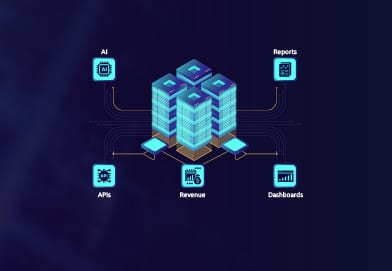In the world of business, data optimization is the new currency. Every interaction, transaction, and piece of feedback forms the foundation for crafting smarter data management strategies. Mismanaging your data, however, is like leaving money on the table.
Implementing a robust data management solution is a significant step toward harnessing the full potential of your data. If your organization has already begun its data management journey, the next phase is about maximizing the value of this investment through continuous data management optimization. This guide offers 8 strategic steps to refine and enhance your data optimization efforts, ensuring they align with your evolving business needs.
With the right approach, you can achieve operational efficiency, accurate and reliable data, and better business outcomes.
1. Establish a Robust Data Governance Framework

Data governance is not a one-time task but an ongoing process that requires regular attention and refinement. Data optimization techniques play a crucial role in maintaining data integrity and compliance. By standardizing data formats and employing consistent data processing, you can ensure that your data is accurate, reliable, and aligned with your business objectives.
For growing organizations, ongoing governance is crucial for adapting data optimization efforts to new challenges and opportunities. Poor data quality costs the U.S. economy approximately $3.1 trillion annually, making a robust governance framework vital.
For example, one construction organization needed to extend the life of its legacy infrastructure while improving data governance. They faced challenges due to low data literacy among staff, making it difficult to maintain governance post-implementation.
We implemented a tailored solution that included regular dashboard checks and alerts to track governance metrics. This approach allowed the company to maintain optimized data independently without additional staff.
Key Components of a Data Governance Framework:
- Data Quality: Implement validation processes to ensure accuracy and enhance data quality.
- Data Security: Enforce strict access controls and encryption to protect data privacy.
- Data Retention: Define policies for data lifecycle management and data transformation.
- Data Access: Establish clear protocols for data accessibility and integration.
2. Implement Continuous Data Quality Monitoring

Data quality is foundational to making informed business decisions. Deploying automated data optimization tools that continuously identify and rectify errors, duplicates, and inconsistencies can significantly enhance the reliability of your data. Continuous monitoring also ensures that your data processing is efficient and aligned with your operational goals.
The McKinsey Global Institute reports that organizations with poor data quality can lose as much as 20% in productivity and see a 30% increase in costs, underscoring the importance of rigorous data quality management.
For instance, a Data-Sleek client in the home services sector faced issues with duplicate customer accounts due to multiple lead-capturing programs. Data-Sleek improved the client’s data quality by implementing a system to eliminate duplicates and set up checks for near-matches. This continuous data optimization allowed them to accurately assess customer density and optimize franchise planning and marketing efforts.
Tips For Ensuring Data Quality In Your Organization:
- Implement automated validation and monitoring tools to maintain accurate data.
- Regularly cleanse data to remove inaccuracies and enhance data quality.
- Utilize dashboards to track and report data quality metrics, ensuring reliable data.
3. Optimize Data Storage Strategies

Efficient data storage is crucial for balancing performance, accessibility, and cost. Regularly reviewing and adjusting your storage strategies as your organization grows ensures scalability and cost-effectiveness. With the global data sphere expected to grow to 175 zettabytes by 2025, scalable storage solutions are becoming increasingly important for managing massive data volumes.
One client undergoing rapid growth due to acquisitions faced challenges with data storage as they integrated new businesses and legacy systems. Data-Sleek recommended a tiered storage system that automatically shifted data between high-performance and cost-effective storage tiers based on usage frequency. This approach optimized data storage and aligned with the organization’s long-term business goals.
As your organization continues to grow, ensure that it has a plan for storage to accommodate growth. Building a data storage strategy includes choosing the right provider, but also regular assessments to your current storage to track progress and gather usage data.
Key Considerations for Optimizing Data Storage:
- Regularly assess storage needs and data usage patterns to optimize data storage.
- Implement tiered storage solutions for cost and performance balance, enhancing operational efficiency.
- Align storage provider selection with long-term business goals to maximize the benefits of data optimization.

4. Conduct Regular Data Audits
Regular data audits are essential for maintaining data integrity, ensuring compliance, and identifying security vulnerabilities. Data audits also play a crucial role in data optimization by uncovering inefficiencies in data processing and integration processes. Organizations that conduct regular data audits report as much as a 50% reduction in data errors.
For example, a finance industry client whose data management system integrates multiple sources used regular audits to fix access control issues. Conducting regular data audits significantly improved the company’s data security posture and provided greater confidence to investors and stakeholders.
Even after implementation of a robust data system, it’s up to your organization to continually monitor and check your processes to make sure everything runs smoothly.
Best Practices for Data Audits:
- Schedule regular audits to assess data integrity, compliance, and the effectiveness of data optimization efforts.
- Utilize automated audit tools for detailed reports and actionable insights.
- Develop an internal audit checklist to promote continuous improvement in data optimization techniques.
5. Strengthen Data Security Protocols

As cyber threats become increasingly sophisticated, regularly updating your data security measures is essential. Implementing advanced security protocols, such as AI-driven threat detection, multi-factor authentication, and regular penetration testing, can protect your data from breaches and enhance data privacy. The average cost of a data breach in 2023 was $4.45 million, emphasizing the importance of robust security measures.
After a system overhaul, a healthcare sector client needed to enhance their data security. Data-Sleek implemented encryption, access controls, and automated compliance checks, significantly reducing the risk of breaches and ensuring compliance with industry regulations.
Beyond an implementation strategy, keeping up with current regulations and updating systems can help prolong the life of your system while protecting your organization from threats–internally and externally.
Practical Steps for Enhancing Data Security:
- Implement encryption and strict access controls to protect data privacy.
- Conduct regular security audits and penetration tests to ensure secure data processing.
- Keep systems updated to the latest security standards to prevent breaches.
6. Create Feedback Loops for Continuous Improvement

Establishing feedback loops allows users to report issues and suggest enhancements, fostering continuous optimization. User feedback is invaluable for identifying system gaps and opportunities for improvement. Gartner found that companies actively collecting and acting on customer feedback experience 20% higher upsell and cross-sell success rates.
For instance, an e-commerce client needed to unify data across multiple sources to streamline operations. Implementing a feedback loop allowed the company to identify key areas for improvement, such as more detailed metrics for business intelligence and data analysis, resulting in a 23% increase in user satisfaction.
Establishing feedback loops isn’t just for client feedback. Regular checks and training can help your organization identify issues quickly before they get out of hand. Don’t have a dedicated data management team or support team? Don’t worry, Data-Sleek offers post-implementation support options that give your organization an extra hand.
Steps to Implement Feedback Loops:
- Establish relevant KPIs to measure the effectiveness of your data optimization efforts.
- Create channels for users to report issues and suggest improvements in data integration processes.
- Regularly review and implement feedback-driven enhancements to maintain optimized data.
7. Have a Clear Plan for Scalability

As your organization grows, your data management system must scale to accommodate increased data volumes and complexity. Developing a scalability roadmap ensures that your system can handle future growth without compromising performance. Scalable data architectures can reduce IT costs by up to 20% while improving data availability and performance.
Scalability planning should include regular assessments of data volumes, data formats, and usage trends, along with scenario planning to anticipate and address potential scaling challenges.
Scalability Planning Tips:
- Regularly assess data volumes, data formats, and usage trends to ensure optimized data processing.
- Identify areas requiring additional resources, such as storage or processing power, to enhance operational efficiency.
- Engage your team in scenario planning to anticipate and address potential scaling challenges in your data optimization efforts.
8. Foster a Data-Driven Culture

A data-driven culture is essential for maximizing the benefits of your data management system. Providing ongoing training and fostering an environment where data is integral to decision-making will ensure your organization’s long-term success. Companies with strong data-driven cultures are three times more likely to report significant improvements in decision-making and business outcomes.
For example, an e-commerce client experiencing rapid growth needed a robust data management system. Data-Sleek built the system and provided comprehensive training, empowering the client to maximize the system’s benefits and scale effectively. This approach also enhanced data analysis and data visualization capabilities, leading to better business outcomes.
Steps to Build a Data-Driven Culture:
- Establish clear communication channels for data-related insights and data optimization techniques.
- Provide regular training and workshops to improve data literacy and standardize data formats.
- Encourage data-driven decision-making across all levels of the organization to enhance data quality and achieve optimized data outcomes.
Closing Thoughts: Empowering Your Organization Through Effective Data Optimization

Implementing a robust data management system is a significant milestone, but it’s only the beginning. Continuous optimization and strategic refinement are essential to fully realizing the benefits of your investment. Following these eight practical steps enables your organization to transform data from a mere asset into a powerful catalyst for growth and innovation.
At Data-Sleek, we’re committed to supporting you every step of the way. Our expertise and tailored solutions are designed to adapt to your unique needs, ensuring that your data management system remains a dynamic and valuable resource. We encourage you to leverage this guide as a roadmap for ongoing improvement and to contact our team for any additional support or consultation.

Your Next Steps:
- Review and Prioritize: Assess which of the outlined data optimization strategies align most closely with your current goals and challenges, and prioritize their implementation accordingly.
- Engage Your Team: Involve key stakeholders and team members in the data optimization process to foster ownership and encourage a collaborative, data-driven environment.
- Monitor Progress: Establish clear metrics and KPIs to track the effectiveness of your data optimization efforts and make adjustments as needed.
- Stay Connected: Maintain open communication with your Data-Sleek support team to ensure you have access to the latest data optimization tools, best practices, and technological innovations.
By continually refining your data management processes, you help safeguard your organization’s valuable information and unlock new opportunities for insight and growth. Together, we can ensure that your data works harder and smarter for you, driving sustained success now and into the future.







